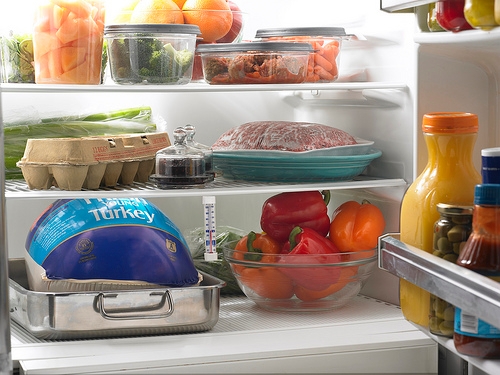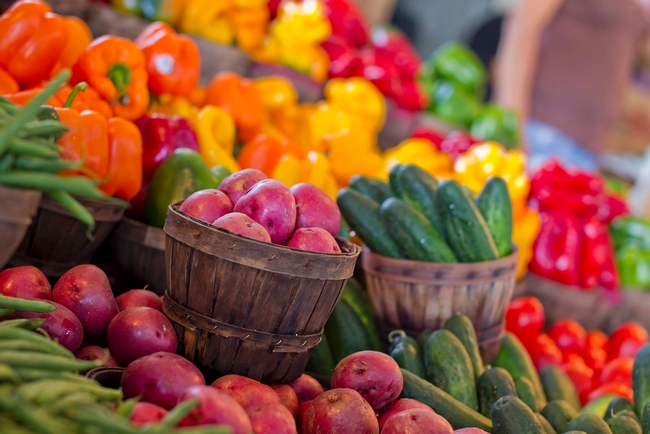Posts Tagged: turkey
Avoid misgivings about food safety at Thanksgiving
I am a terrible cook. My brother is an excellent cook. One year he told me his turkey was thawing in the bathtub because it was too big for the refrigerator and my enthusiasm for dining at his house began to cool.
“The prevention plan for food safety begins with planning the feast, knowing when a frozen turkey needs to start defrosting in the refrigerator so there is ample time to thaw,” says Connie Schneider, director of UC Agriculture and Natural Resources Youth, Families and Communities Statewide Program. “What size turkey will you defrost? Is there enough space to thaw the turkey safely?”
To avoid making diners sick, the traditional fowl should be thawed at temperatures below 40 degrees F. The "Danger Zone," temperatures where foodborne bacteria multiply rapidly, is between 40 and 140 degrees F.
“People thaw on the counter, they put their turkeys in the garage to thaw out,” says Schneider, in a “can you believe there are such fools?” tone that warns me that I should not admit to doing this. “They also place dinner leftovers, especially the big turkey, in the garage because of lack of refrigerator space.”
The registered dietitian advises, “When using refrigerator thawing, place the turkey in its original wrapping placed in a pan, which prevents dripping as turkey defrosts.”
A whole turkey weighing 4 to 12 pounds takes 1 to 3 days to thaw in a refrigerator. Heavier turkeys take longer. A thawed turkey can remain in the refrigerator for 1 or 2 days before cooking.
If your turkey weighs more than 12 pounds and today is Tuesday and you haven’t begun thawing it, you may have to resort to Plan B for thawing the bird or ordering Chinese food on Thursday.
According to the USDA Food Safety and Inspection Service website, there are three safe ways to thaw food: in the refrigerator, in cold water and in the microwave oven. Procrastinators will be thawing their birds in cold water or in the microwave. For details on quicker thawing, see the USDA website: http://www.fsis.usda.gov/wps/portal/fsis/topics/food-safety-education/get-answers/food-safety-fact-sheets/poultry-preparation/turkey-basics-safe-thawing/ct_index.
Schneider also reminds us to prevent cross-contamination of foods. For example, don’t wash or rinse the turkey before cooking because the rinse water may splash bacteria around the sink, which can then come into contact with other foods and utensils. Another way to prevent cross-contamination is prepping the stuffing ingredients before you handle the raw turkey. Keep the raw turkey and their juices away from other foods. After you prep your raw turkey, wash the cutting board, knife, sink and counter tops with hot, soapy water. Sanitize cutting boards with a solution of 1 tablespoon of unscented, liquid chlorine bleach in 1 gallon of water. Wash your hands with soap and warm water frequently and always after handing raw foods. And for crying out loud (to invoke a phrase my late father used), don’t wipe your dirty hands on a towel that will be used to dry clean dishes later!
Planning is also needed for storing leftover food after the meal, cautions Schneider. “Everyone loves leftovers, but make sure you have adequate refrigeration space.”
She recommends wrapping leftovers in airtight packaging or sealing in storage containers. This helps keep out bacteria while keeping your food moist and preventing your prized family dishes from picking up odors from other foods being stored in the fridge. For faster cooling, break up large amounts of food into smaller containers.
“Toss out any food that has been left out for more than 2 hours at room temperature!” Schneider admonishes. “Don’t allow your turkey to sit out, slice up the leftovers and refrigerate or freeze them right after your meal!”
Delicious leftovers that have been stored in the refrigerator can be enjoyed for 3 to 4 days. If you freeze them, you can eat them 3 or 4 months from now.
This Thanksgiving, I will be thanking God for allowing my family and me to survive our lackadaisical food handling on previous holidays. Happy Thanksgiving to you and your loved ones!
For more information on food safety, visit http://www.fsis.usda.gov/wps/portal/fsis/topics/food-safety-education/get-answers/food-safety-fact-sheets/safe-food-handling/keep-food-safe-food-safety-basics/ct_index.
What's in your compost?
For home gardeners, spring is a busy time of year and there’s never a tomato with more flavor than one grown to full ripeness on the vine. But there are also many safety precautions to follow to prevent contamination of fruits and vegetables with pathogens that cause serious food-borne illnesses.
Michele Jay-Russell, a veterinarian and research microbiologist at the Western Institute for Food Safety and Security (WIFSS) and program manager of the Western Center for Food Safety (WCFS), recently co-authored a study that highlights the need to be aware of the hazards associated with using raw animal manure to fertilize home gardens. (Read full article here.)
The basis for the study began in July of 2010 when a shire mare from a rural Northern California farm was brought to the William R. Pritchard Veterinary Medical Teaching Hospital for treatment of colic. Following protocol, the veterinarians on call screened the horse for Salmonella to avoid infecting other horses during hospitalization. She tested positive and after successful treatment for colic, went home. Her owners then notified the veterinarians that some of their other draft horses were sick as well — all 8 were tested and 6 came back positive for the same Salmonella Oranienburg strain, including the mare that still had the infection.
Jay-Russell heard about the case from her colleague John Madigan, professor of medicine and epidemiology at the school. The farm’s owners invited Jay-Russell and Madigan to the farm to see if they could uncover the source of the Salmonella infection. They sampled water from horse troughs, manure storage piles, wild turkey feces and soil from the family’s edible home garden where raw horse manure had been used as fertilizer. Each of those locations had a percentage of positive samples over the sampling period from August 2010 to March 2011.
“We showed the owners how to continue collecting samples and provided them with a FedEx number to ship them to UC Davis,” Jay-Russell said. “During that whole time, the garden soil kept coming back positive, which showed that this strain of Salmonella could persist for months.”
While the researchers couldn’t be completely certain about the original source of Salmonella on the farm, they suspect that a recent surge in the wild turkey population on the property introduced the bacteria to the horses by pooping in the horse corrals and in the water troughs. They speculated that the wild turkeys brought the Salmonella onto the property, although they couldn’t rule out the possibility that the birds were exposed on the farm or to other potential sources of Salmonella.
“What is clearer is that the raw horse manure applied as fertilizer was the most likely source of garden soil contamination,” Jay-Russell explained. “We suspect that the damp climate in Mendocino County may have contributed to the longevity of this bacterium in the soil long after the owners stopped applying the horse manure to the garden. Fortunately, the owners didn’t get sick, but our investigation showed the potential for widespread dissemination of Salmonella in a farm environment following equine infection.”
To promote safe gardening practices, Jay-Russell has teamed with Trevor Suslow, a Cooperative Extension food safety specialist in the Department of Plant Sciences, to speak to groups of small farmers around the state about best practices. They also use a brochure in English and Spanish, “Food Safety Tips for Your Edible Home Garden,” that includes information about safe uses of animal manure and ways to minimize animal fecal contamination.
“It’s good to let people know about the risks and to correct misinformation about ways to treat the compost pile before using it in the garden,” Jay-Russell said. “The biggest take home message from this experience is to be very careful about using manure from sick horses — and to be cautious about offers of free manure — you don’t know what’s in there. Commercial compost should be bought from a reputable source.”
She urges gardeners to take a class and learn how to compost correctly and safely. Each county in California has UC Cooperative Extension advisors and many have Master Gardener programs offering information on food safety.
Additional resources:
Holiday food safety
Why is there a turkey in the garage?! If you’ve ever found yourself asking any variant of this question, trust us - you’re going to want to read on.
As the holiday season approaches, we begin to think about spending time with our families, enjoying one another’s company over the many feasts that accompany special days. While we may set aside mindful eating during the holiday season, we should not set aside food safety.
In many families, once the holiday meal is served it may sit on the table for 2-3 hours while people come and go, “picking” from the various serving dishes. The most creative food safety flub goes to a family member who thaws her holiday turkey in her garage. Her justification of this practice? “I haven’t hurt anyone yet!”
With respect for time-honored traditions, might we suggest that this festive time of giving and sharing SHOULD NOT include sharing foodborne illness by forgetting food safety measures? In many California counties, we may still have some heat lingering late into the November month. How much harm can the garage thawing method, or “GTM” if you will, really have? After all, we will be cooking it appropriately right? Wrong!
A few turkey thawing tips:
- If thawing your turkey in the refrigerator; plan for 24 hours per 4-5 pounds of turkey.
- Place the turkey into a container to avoid contaminating other foods.
- If thawing your turkey in cold water; plan for 30 minutes per 1 pound of turkey. Remember to change the water every 30 minutes.
- If thawing your turkey in the microwave;
follow the manufacturer guidelines.
- A turkey thawed in cold water or in the microwave must be cooked immediately.
(Photo: USDA)
Cooking your turkey properly ensures that all harmful bacteria have been destroyed.
Cooking time ranges from 2¾ hours to 5¼ hours depending on size and whether the turkey is stuffed. To check the temperature of a properly cooked turkey, one should insert the thermometer into the innermost part of the thigh and wing as well as the thickest part of the breast; proper temperature should read 165 degrees. Once all parts have reached this minimum temperature, it is safe to eat, even if parts should remain pink. Stuffing should read 165 degrees when properly cooked as well.
Here are a few tips to keep your foods safe when storing leftovers:
- Cut turkey or other meats into smaller pieces. Store stuffing separately.
- Divide large quantities of food items into smaller portions before storing.
- Store different food items separately.
- Turkey that is stored in the refrigerator can be held for 3-4 days; reheat to 165 degrees.
- Frozen turkey can be stored for 2-6 months; reheat to 165 degrees.
Enjoy your holiday feast and be sure to keep your foods safe!
These tips and more can be found at http://www.fsis.usda.gov/.
Blog contributors: Connie Schneider, Ph.D., R.D., Laurin Herrera, CSUF Dietetic Intern, & Shelby MacNab, Nutrition Program Manager





